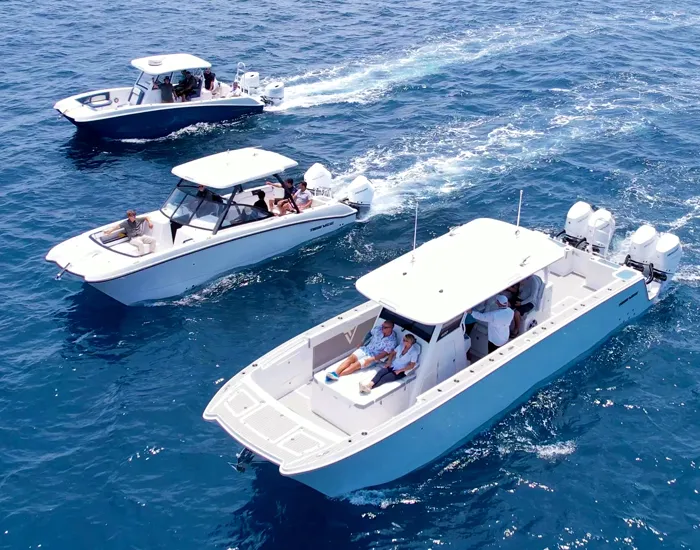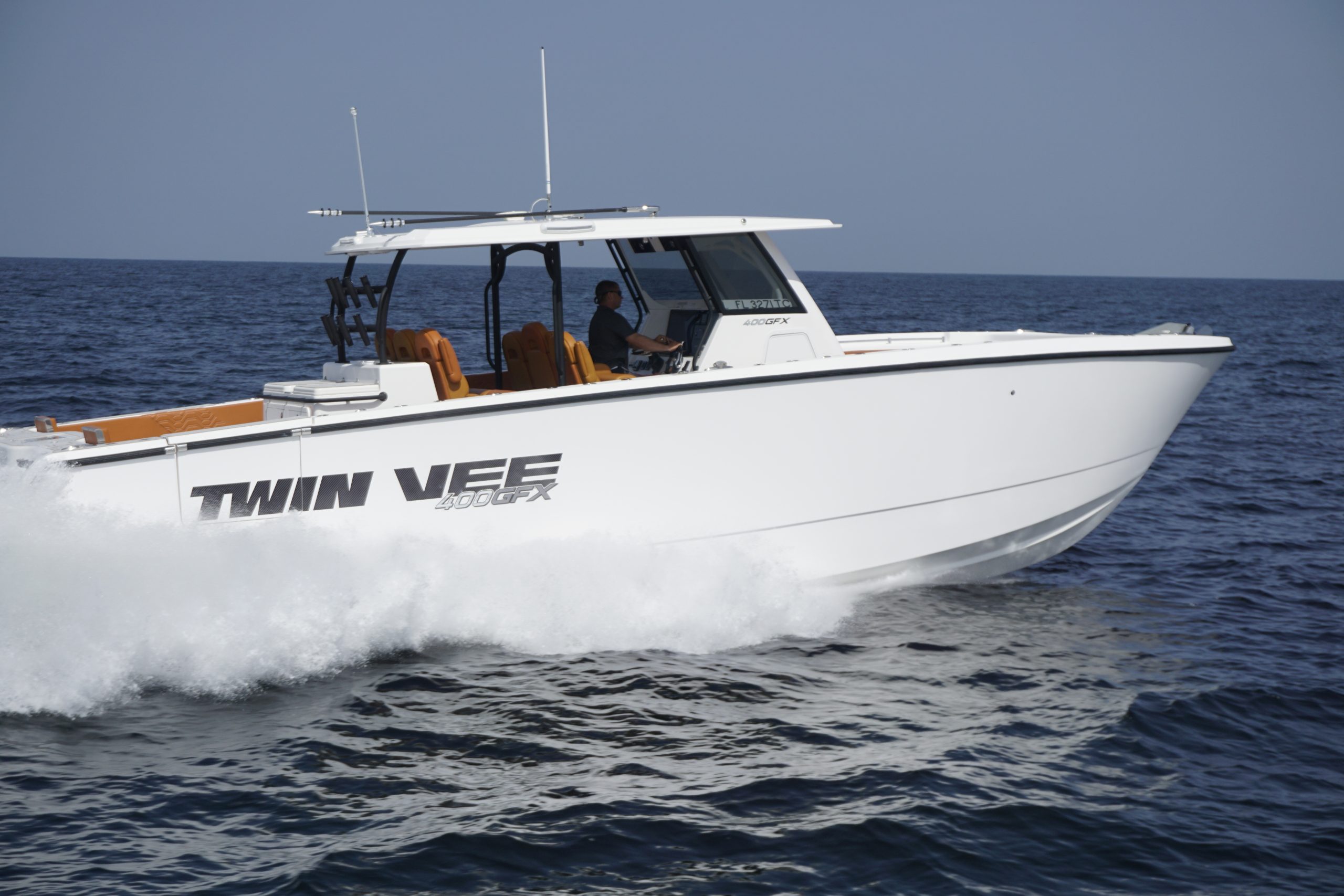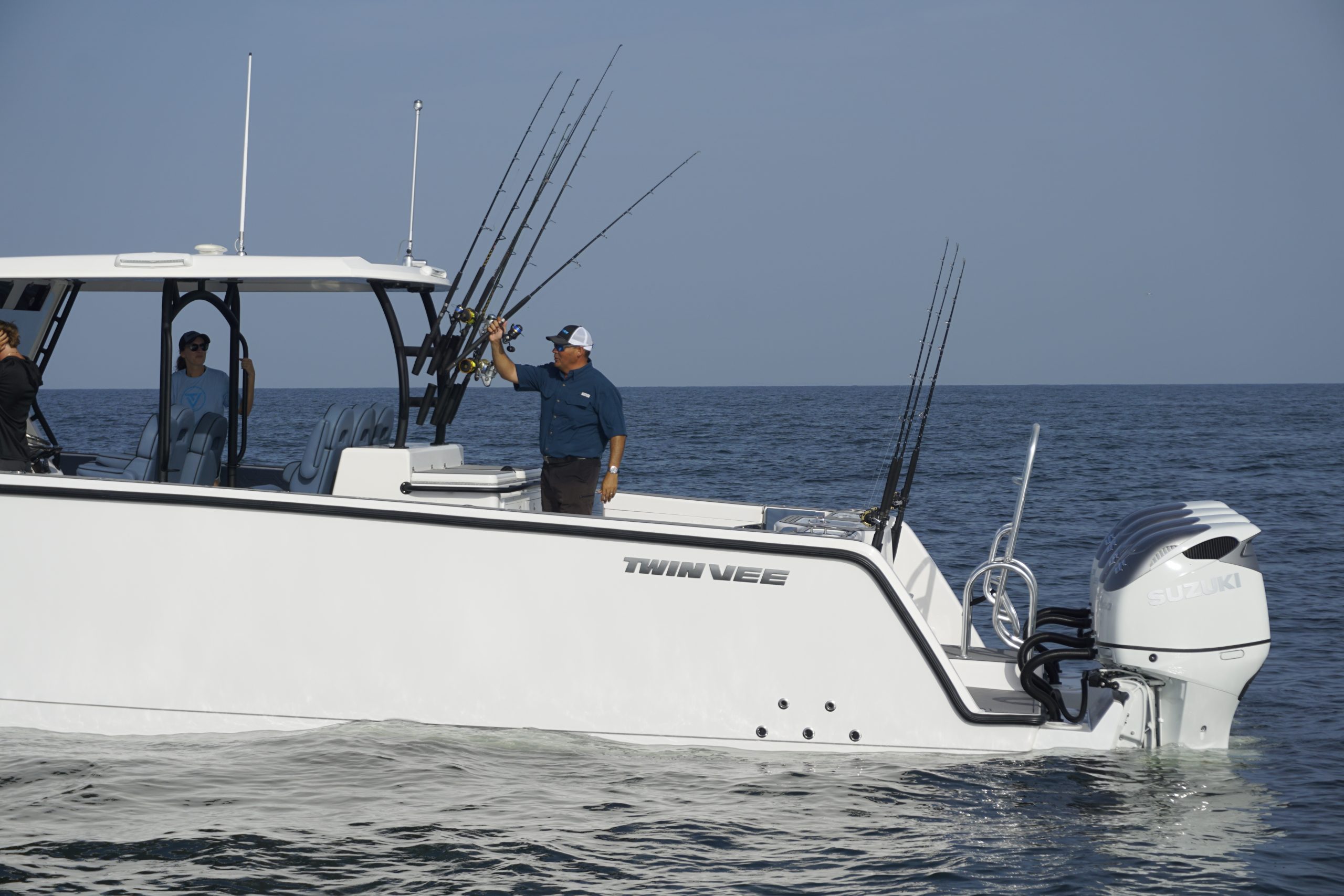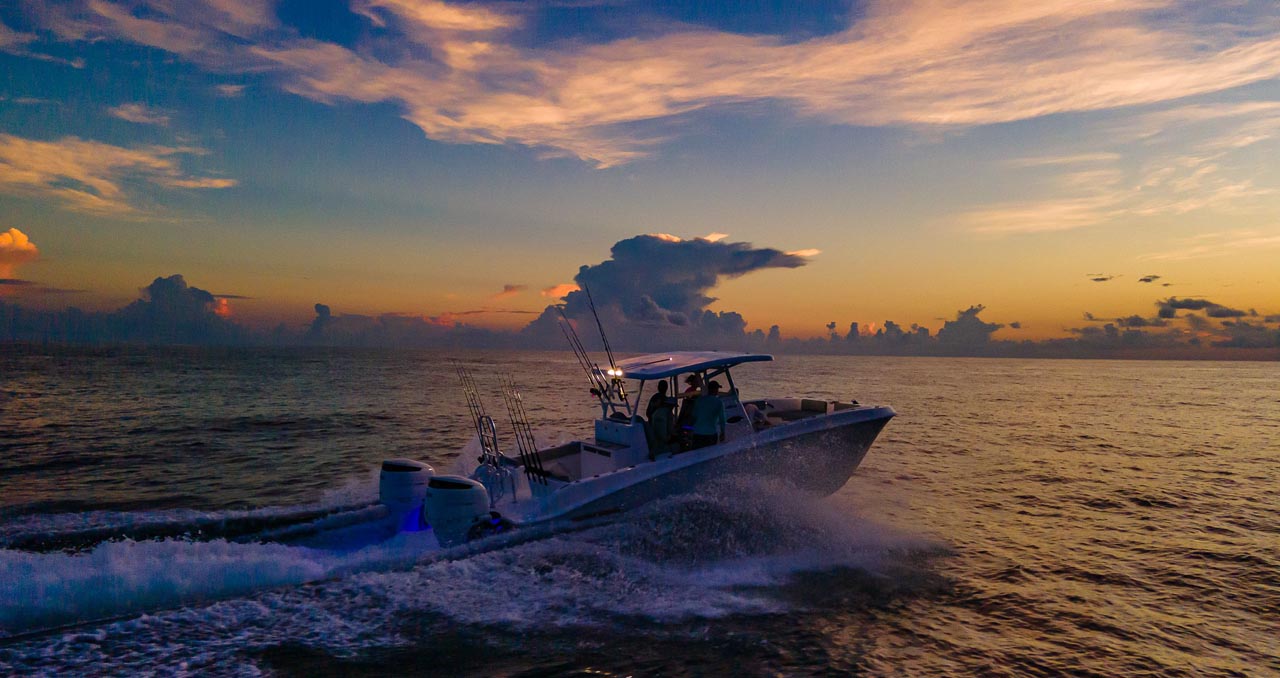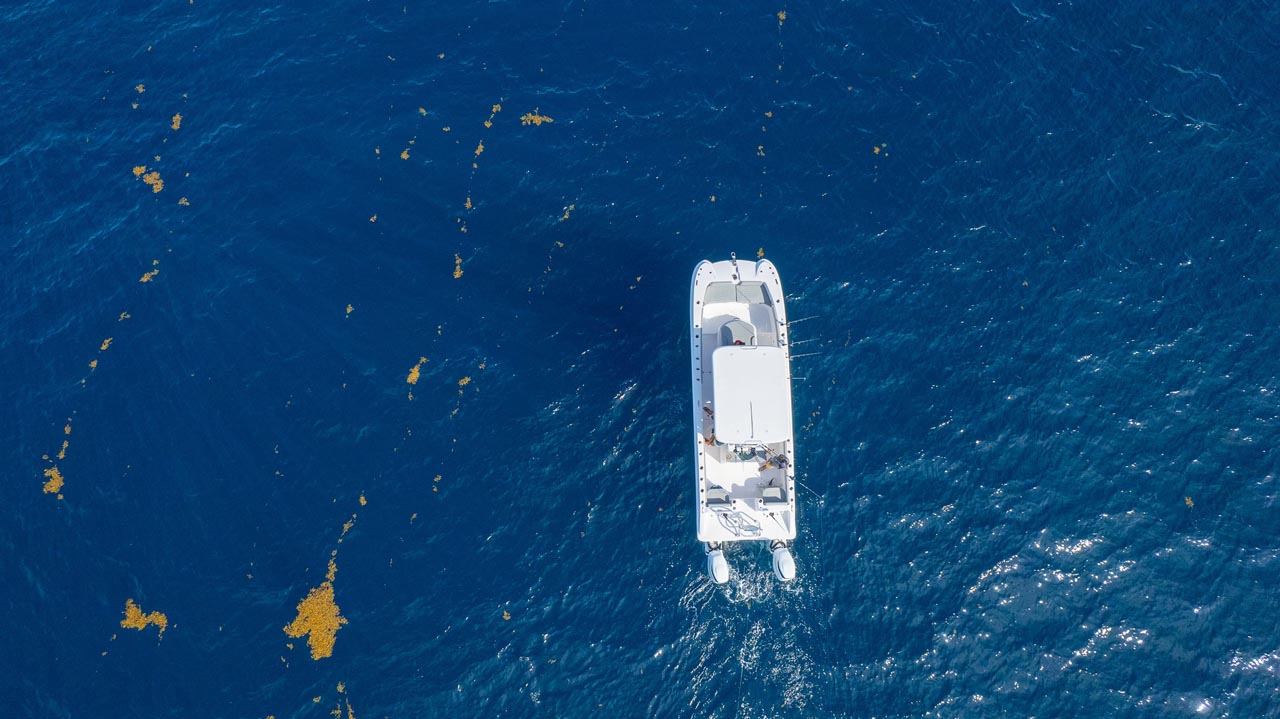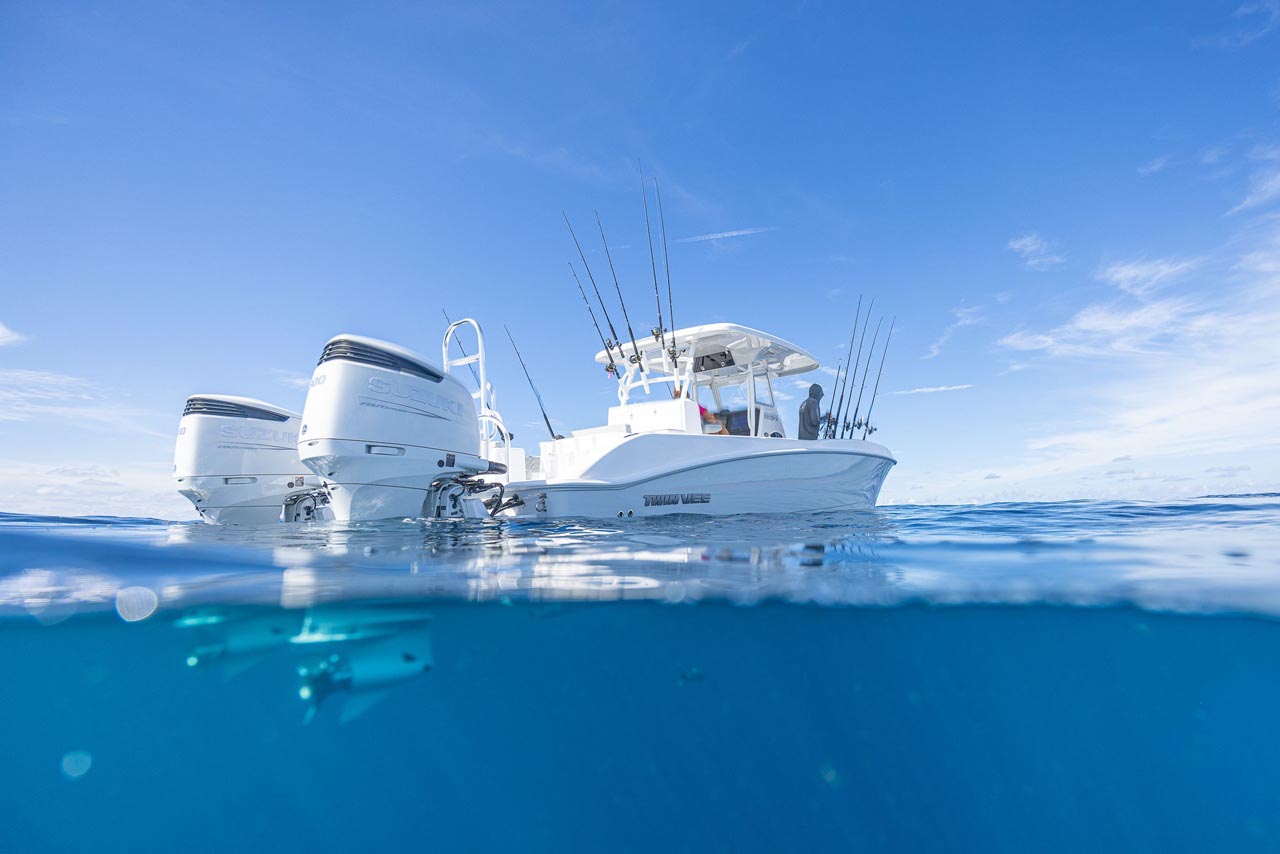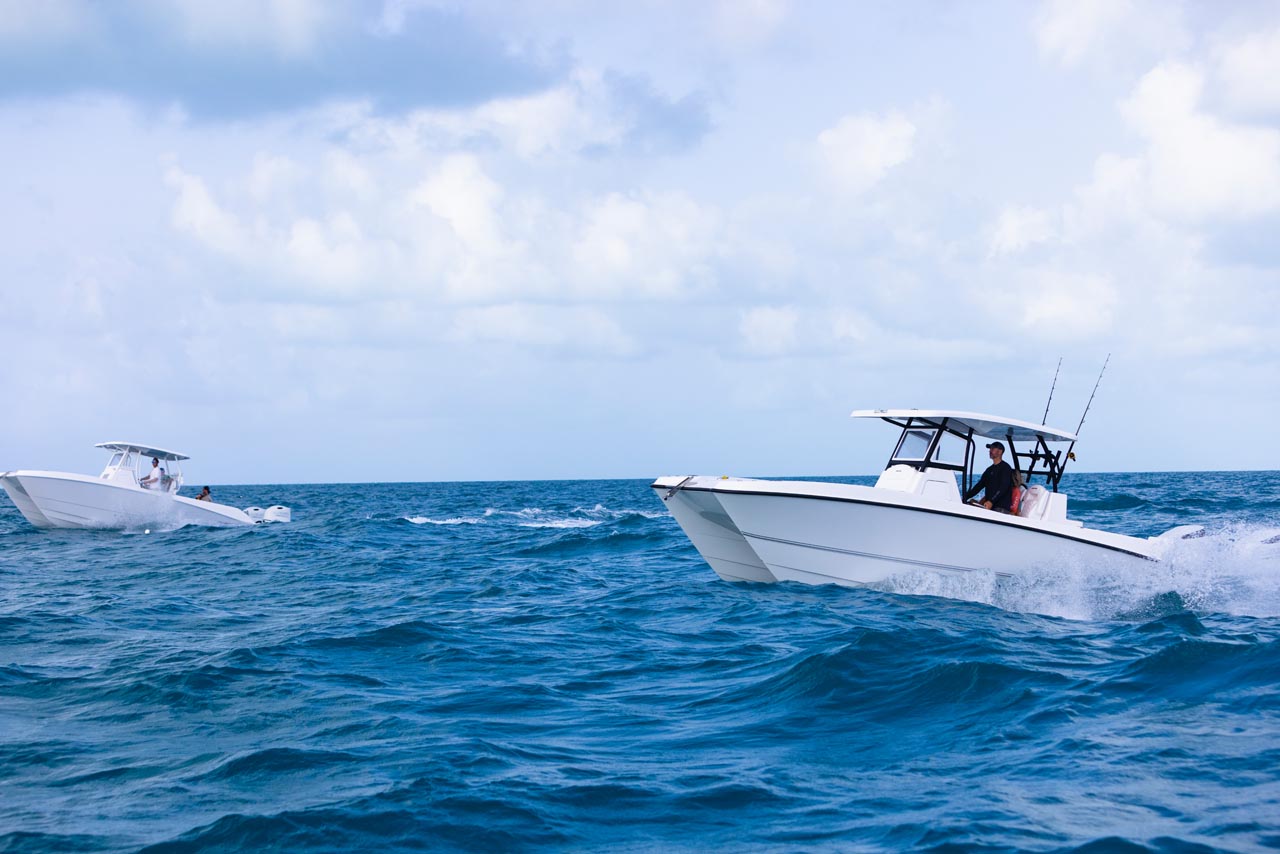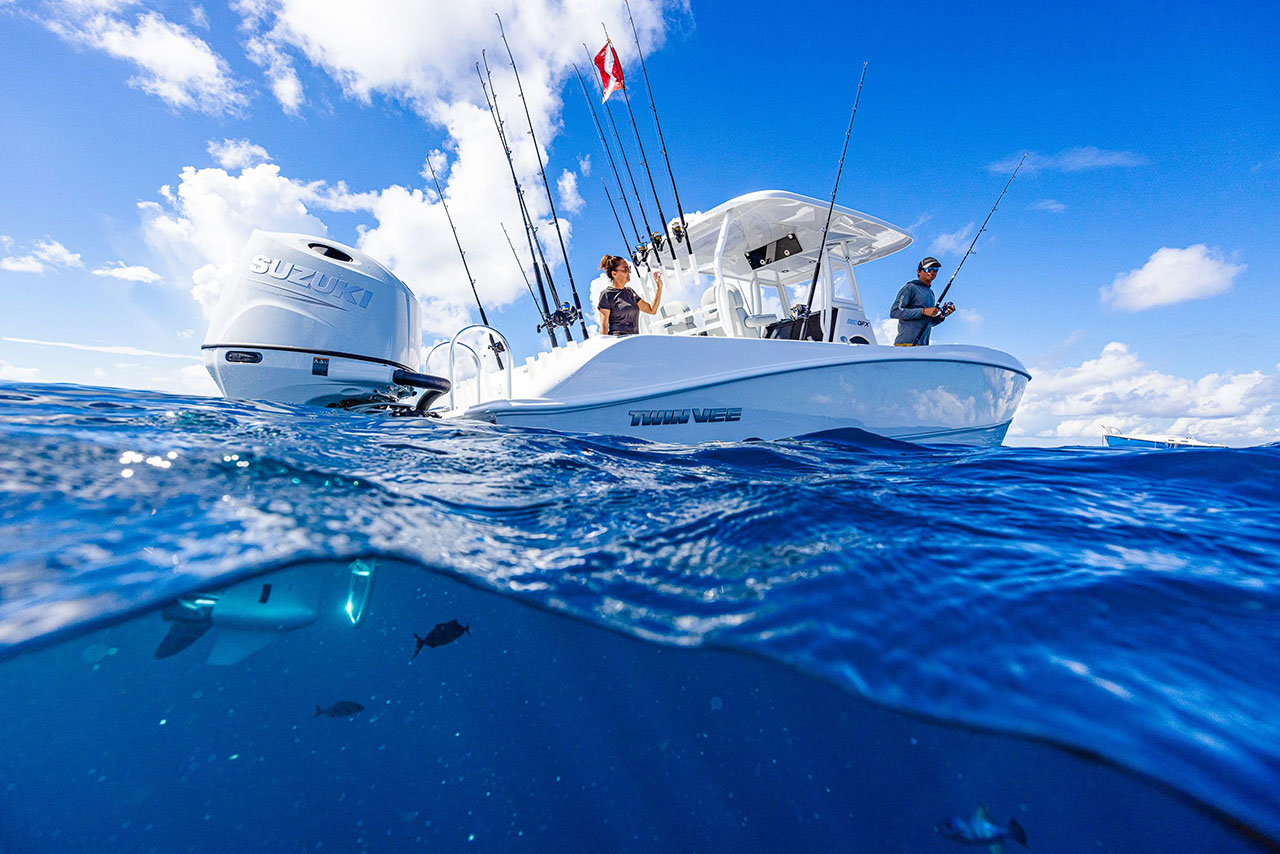
CATAMARAN BOAT ADVANTAGES
As a Twin Vee moves through the water, the boat hull has lifting strakes on each hull’s side. Lifting strakes produce lift at the bow of the boat by displacing water, allowing the boat to, in essence, glide above the water rather than lumber through it. Many lifting strake designs use negative angles, which can generate lift. Twin Vee’s lifting strakes work to not only create lift but also to make the ride smoother. A catamaran boat’s forward motion lifts water toward the top of the tunnel while pushing the water inward to form two counter-flowing vortexes. As these vortexes are formed, the unique Twin Vee hull design aerates them with small air bubbles, which are then compressed at an increasing rate as the vortexes move down the tunnel.
It is the kinetic energy stored in these compressed air bubbles that creates a smooth and stable ride. As speed increases, the kinetic energy increases at a non-linear rate as more and more air is inducted into the increasingly faster-flowing vortexes. The Twin Vee hulls’ trailing surfaces are specifically designed to facilitate propulsion efficiency by discharging the kinetic energy and air bubbles from the counter-flowing vortexes upon exiting astern, thus providing the propellers with a steady flow of super clean and highly-ordered water.
This fact, combined with a catamaran’s soft ride, results in Twin Vee’s renowned efficiency and smooth, seaworthy safety. At speed, the Twin Vee’s displacement hull slices through the water, traveling by the sea’s shape rather than flying over them and experiencing reentry shock. This results in a stable and smooth ride.
Wider Footprint
The twin-hull design of a Twin Vee catamaran maximizes stability by distributing buoyant forces along the outer edges of the boat. This configuration significantly reduces the rolling motion caused by waves, making it ideal for open water and rough conditions.
Key Science:
- Moment of Inertia: The wider hulls create a higher moment of inertia, which resists rolling compared to the narrow beam of monohulls.
- Wave Dispersion: The dual hulls work in tandem to disperse wave energy, reducing pitch and roll.
This stability makes Twin Vee boats perfect for activities like fishing, diving, and entertaining, where a steady platform is essential.


Shallow Draft for Exploring Remote Waters
Twin Vee boats are designed with a shallow draft that allows you to access areas that are off- limits to deeper-draft monohulls. By distributing weight across two hulls, Twin Vee catamarans can navigate shallow bays, sandbars, and tidal flats with ease.
Key Science:
- Reduced Displacement Per Hull: Each hull displaces less water, reducing draft.
- Minimal Drag in Skinny Waters: The narrow profile of each hull decreases resistance, allowing smooth navigation in areas with limited depth.
With a draft as shallow as 14 inches on some models, Twin Vee catamarans are ideal for coastal and inshore cruising.
Advanced Construction and Materials
Twin Vee catamarans are built using closed-molded vacuum infusion technology, ensuring consistent quality and strength.
Key Features:
- Composite Construction: Lightweight yet durable materials reduce weight without sacrificing strength.
- UV-Resistant Gelcoat: Protects against sun damage for long-lasting performance.
- Reinforced Stringer Systems: Adds structural integrity to handle tough conditions.


Fuel Efficiency and Hydrodynamics
Twin Vee catamarans are designed with efficiency in mind. The twin-hull design reduces drag and optimizes fuel consumption, saving you money on every trip.
Key Science:
- Reduced Wetted Surface Area: The narrow hulls contact less water, decreasing drag.
- Tunnel Hydrodynamics: The tunnel between the hulls promotes kinetic fluid induction, directing water flow efficiently and reducing resistance.
- Laminar Flow: The sleek hull design minimizes turbulence, improving speed and fuel economy.
These innovations make Twin Vee boats more environmentally friendly while delivering superior performance.
Single-Engine Get-Home Capability for Safety
Twin Vee catamarans are powered by twin engines, but their advanced design allows them to perform effectively even on a single engine. This redundancy ensures peace of mind in any situation.
Key Science:
- Balanced Load Distribution: The twin hulls maintain stability and trim even when powered by a single engine.
- Hydrodynamic Efficiency: The design reduces reliance on planing speed, allowing steady travel on one engine.
This capability enhances safety, especially for offshore adventures where reliability is crucial.


Maximized Deck Space for Utility and Comfort
Twin Vee catamarans offer a rectangular deck layout, providing significantly more usable space compared to the tapered design of monohulls. This layout allows for more efficient use of space for seating, storage, and movement.
Key Science:
- Optimal Beam Utilization: The wide beam extends the deck to the full width of the boat, maximizing available square footage.
- Reduced Centerline Constraints: Without a keel or pronounced taper, the layout is open and versatile.
From spacious casting decks to ample seating for passengers, Twin Vee boats deliver the flexibility you need for any activity.
Fuel Efficiency and Hydrodynamics
Twin Vee catamarans are designed with efficiency in mind. The twin-hull design reduces drag and optimizes fuel consumption, saving you money on every trip.
Key Science:
- Reduced Wetted Surface Area: The narrow hulls contact less water, decreasing drag.
- Tunnel Hydrodynamics: The tunnel between the hulls promotes kinetic fluid induction, directing water flow efficiently and reducing resistance.
- Laminar Flow: The sleek hull design minimizes turbulence, improving speed and fuel economy.
These innovations make Twin Vee boats more environmentally friendly while delivering superior performance.


Minimal Bow Rise for Enhanced Visibility
Unlike monohulls, which often experience significant bow rise during acceleration, Twin Vee catamarans maintain a flat, parallel deck at all speeds.
Key Science:
- Dynamic Stability: The twin-hull design evenly distributes lift forces, preventing excessive bow rise.
- Improved Center of Gravity: The boat’s weight is distributed lower and wider, enhancing balance.
This design feature not only improves acceleration and speed but also contributes to a more comfortable ride, especially in rough seas.
Superior Load-Bearing Capability
Whether you’re carrying heavy equipment, a full fishing crew, or recreational gear, Twin Vee catamarans excel under load. The twin-hull structure distributes weight evenly across a larger surface area, minimizing the impact on performance.
Key Science:
- Enhanced Buoyancy Distribution: Two hulls provide greater displacement, enabling the boat to support heavier loads without compromising performance.
- Self-Bailing Deck Design: Engineered to channel water efficiently, the deck remains clear even at maximum load capacity.
This design ensures that Twin Vee boats perform optimally, whether you’re heading offshore or hosting a gathering on deck.


Precise Maneuverability for Docking and Tight Spaces
Twin Vee catamarans excel in handling, especially in tight spaces like marinas. The wider separation between engines enables unparalleled control.
Key Science:
- Independent Thrust Vectors: With engines placed on separate hulls, you can pivot the boat with precision by cross-clutching.
- Shorter Turning Radius: The dual-hull design allows for tighter turns compared to monohulls of the same size.
This makes docking and maneuvering stress-free, even in challenging conditions.
Smaller Wake for Environmental Impact
Twin Vee boats generate smaller wakes at high speeds, reducing their impact on the environment and other boaters.
Key Science:
- Wave Interference: The dual hulls create smaller waves that cancel each other out in the tunnel.
- Reduced Wake Energy: Less wetted surface area means less energy transferred to the water.
This feature is particularly important in no-wake zones and environmentally sensitive areas.

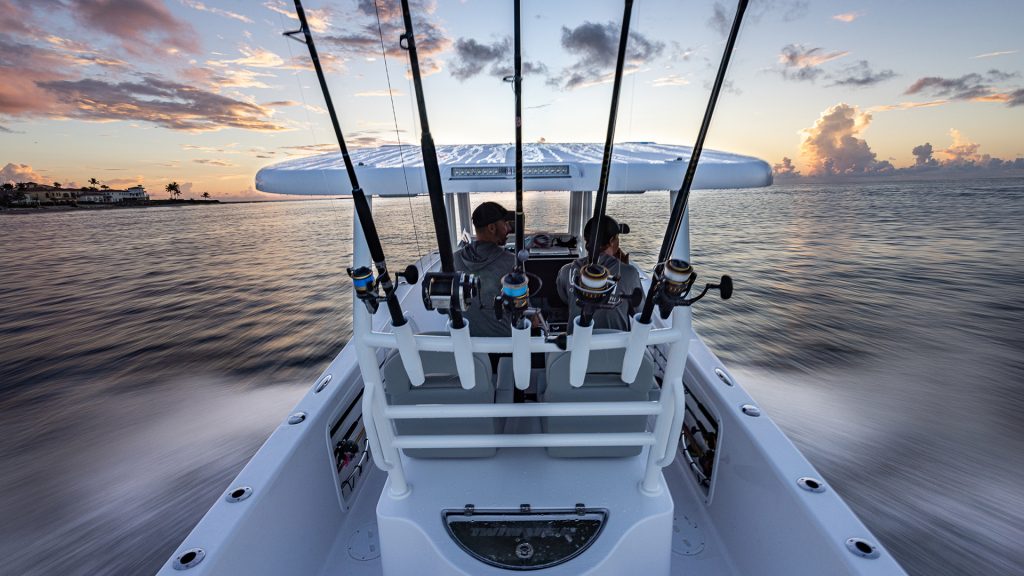
360° Fishability with Superior Stability
Twin Vee catamarans excel in handling, especially in tight spaces like marinas. The wider separation between engines enables unparalleled control.
Fishing enthusiasts will love the ability to fish from any side of the boat without worrying about listing. The twin-hull design keeps the deck stable, even with uneven weight distribution.
Key Science:
- Wide Beam Stability: The dual hulls maintain a steady platform, no matter where the weight shifts.
- Hydrodynamic Symmetry: Balanced forces ensure the boat stays level under all conditions.
This stability provides a safer and more enjoyable fishing experience, even in rough waters.
Twin Vee: The Science of Better Boating
Every Twin Vee catamaran is a product of meticulous engineering and hydrodynamic expertise. From greater stability and efficiency to advanced safety and performance features, our boats are designed to meet the demands of today’s boaters. Whether you’re exploring shallow waters, heading offshore, or simply enjoying a day on the water, Twin Vee catamarans deliver the science-backed performance you deserve.
Discover the difference with Twin Vee PowerCats – where innovation meets the open water.


Catamaran twin hull shapes, specifically Twin Vee boats, are designed to exploit the phenomenon of kinetic fluid induction to produce what we believe to be the driest and smoothest ride of any boat in their class.













